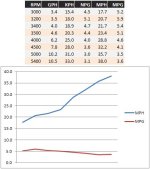Les Lampman
New member
- Joined
- Oct 30, 2003
- Messages
- 779
- Reaction score
- 1
A0001 (production hull #1) went in the water early this morning for her builder's trials. I learned a lot and it changes some of the concepts I had about the boat.
As many know this boat has been powered with a Honda BF115D, which is really a detuned BF135/150. It's a large block for a 115-hp engine and because of that it only has about 2 ft-lbs of torque less than the BF150. What's really neat though is that peak torque comes in at a fairly low 3,500 rpm, and that turns out to be the cat's meow for this hull.
I was confident based on Dave's prototype M215 that it would handle the weight of the Honda BF115D (the result of it being the same engine as the BF135/150) and the kicker too. Of course, that was "paper" confidence since no M215 existed at that point equipped like that. Well, it's paper confidence no more; with full fuel, full water, the BF115D and the Tohatsu 9.8 kicker the boat sits dead level in the water and handles beautifully. In this configuration with two folks aboard the M215 planes out just shy of 9 knots.
The other thing is that I underestimated the speed range of the hull. With the E-TEC 90 on Dave's M215 I typically cruised the boat about 18 to 20 knots but I've now found out that was mostly due to noise and the sound of the engine. With the now quieter boat (and engine) with the BF115 the Marinaut cruises comfortably at 25 knots. And that's not in flat water, I ran that speed though some pretty good tide rip chop and the hull doesn't pound and slap. With the BF115 cruising at 20 knots (23 mph) is pretty effortless at 3500 rpm (fuel consumption at that rpm is 4.6 gph).
So, my take is with a 90-hp engine the M215 feels closer to the CD22 (still a little faster at cruise if wanted). With a 115-hp engine it feels very close to an Arima 21 Hardtop with a 150-hp engine. Truly either engine works great, it's just going to be about either the cruise speed you want or the weight you want to haul.
I've got the NMEA 2000 bus connected to the BF115D and to the Raymarine C90W which gives rpm, fuel burn, voltage, engine coolant temp, engine hours, etc right from the engine's ECU to the C90W display. The following numbers come from the engine for rpm and fuel burn and from the GPS (speed over ground) for the speed (and I tried to average by running multiple directions).
Here's the chart I generated this morning (keep in mind this is a M215 with full fuel and full water but not a lot of other gear) running an aluminum Solas (Honda OEM) 3-bladed 17" prop.
3000 rpm..........3.4 gph..........15.4 kts
3500 rpm..........4.6 gph..........20.3 kts
4000 rpm..........6.2 gph..........25 kts
4500 rpm..........7.8 gph..........28 kts
5000 rpm..........10.2 gph.........31 kts
5400 rpm..........10.5 gph.........33 kts
The BF115D makes maximum horsepower at 5,250 rpm so I'm pretty happy with where the 3 x 17 prop ended up. If the rpm drops much when fully loaded (gear and people) I'd be inclined to try a 4 x 15 prop. A 3 x 15 would work but I think it may take the rpm up higher than needed; not higher than redline (6,000 rpm) but high enough that you'd lose the benefit of the down low torque on the BF115D.
Another speed I found I really liked this morning was running 3200 rpm at 18 kts with a fuel burn of 3.5 gph. Running 3400 rpm at almost 19 kts (like 18.8 to 18.9) with a fuel burn of 4 gph was also a nice speed.
All-in-all I consider the M215 to be what I would call a "20 knot cruise boat" and with a 115-hp engine a bit higher speeds are still quite comfortable.
I still found that the boat tracks like an arrow. It will run for quite some time hands-off and not wander around. I run with the autopilot doing the steering duties about 90% of the time but having a boat that tracks like the M215 means the autopilot is working easier.
To say I'm pleased would be an understatement. Of course since I build the things I'm biased but I'm also honest enough to "tell it like it is" regardless of whether it helps or hurts me. Folks that are going to spend this much money (any amount really) are owed the truth.
I had the hard bulkhead in this morning but I have to tell you this boat is superb with the aft bulkhead out. What an open feeling that gives the boat. Of course in the winter (in the PNW) I'd have it in but I can really see removing it in the spring and leaving the cabin open to the cockpit (with a Bimini or camper canvas is the best).
In being aboard the M215 with the aft bulkhead removed and the full camper canvas up I thought "what a great family boat". That's not what I was thinking before that. It seemed like a great couple's boat. But with the aft bulkhead removed and the camper canvas up there is so much inside space, plenty for 5 or 6 people to move around and be comfortable. Plenty for a couple with a couple of kids or so to camp aboard; mom and dad at one end and the kids in the other...still visible and easy to keep track of and close at hand if needed. There's comfortable sleeping on the v-berth and a really comfortable sleeping space in the cockpit with something like an air mattress in place.
Thanks everyone for being here and being part of the process (and the joy).
All the best...
As many know this boat has been powered with a Honda BF115D, which is really a detuned BF135/150. It's a large block for a 115-hp engine and because of that it only has about 2 ft-lbs of torque less than the BF150. What's really neat though is that peak torque comes in at a fairly low 3,500 rpm, and that turns out to be the cat's meow for this hull.
I was confident based on Dave's prototype M215 that it would handle the weight of the Honda BF115D (the result of it being the same engine as the BF135/150) and the kicker too. Of course, that was "paper" confidence since no M215 existed at that point equipped like that. Well, it's paper confidence no more; with full fuel, full water, the BF115D and the Tohatsu 9.8 kicker the boat sits dead level in the water and handles beautifully. In this configuration with two folks aboard the M215 planes out just shy of 9 knots.
The other thing is that I underestimated the speed range of the hull. With the E-TEC 90 on Dave's M215 I typically cruised the boat about 18 to 20 knots but I've now found out that was mostly due to noise and the sound of the engine. With the now quieter boat (and engine) with the BF115 the Marinaut cruises comfortably at 25 knots. And that's not in flat water, I ran that speed though some pretty good tide rip chop and the hull doesn't pound and slap. With the BF115 cruising at 20 knots (23 mph) is pretty effortless at 3500 rpm (fuel consumption at that rpm is 4.6 gph).
So, my take is with a 90-hp engine the M215 feels closer to the CD22 (still a little faster at cruise if wanted). With a 115-hp engine it feels very close to an Arima 21 Hardtop with a 150-hp engine. Truly either engine works great, it's just going to be about either the cruise speed you want or the weight you want to haul.
I've got the NMEA 2000 bus connected to the BF115D and to the Raymarine C90W which gives rpm, fuel burn, voltage, engine coolant temp, engine hours, etc right from the engine's ECU to the C90W display. The following numbers come from the engine for rpm and fuel burn and from the GPS (speed over ground) for the speed (and I tried to average by running multiple directions).
Here's the chart I generated this morning (keep in mind this is a M215 with full fuel and full water but not a lot of other gear) running an aluminum Solas (Honda OEM) 3-bladed 17" prop.
3000 rpm..........3.4 gph..........15.4 kts
3500 rpm..........4.6 gph..........20.3 kts
4000 rpm..........6.2 gph..........25 kts
4500 rpm..........7.8 gph..........28 kts
5000 rpm..........10.2 gph.........31 kts
5400 rpm..........10.5 gph.........33 kts
The BF115D makes maximum horsepower at 5,250 rpm so I'm pretty happy with where the 3 x 17 prop ended up. If the rpm drops much when fully loaded (gear and people) I'd be inclined to try a 4 x 15 prop. A 3 x 15 would work but I think it may take the rpm up higher than needed; not higher than redline (6,000 rpm) but high enough that you'd lose the benefit of the down low torque on the BF115D.
Another speed I found I really liked this morning was running 3200 rpm at 18 kts with a fuel burn of 3.5 gph. Running 3400 rpm at almost 19 kts (like 18.8 to 18.9) with a fuel burn of 4 gph was also a nice speed.
All-in-all I consider the M215 to be what I would call a "20 knot cruise boat" and with a 115-hp engine a bit higher speeds are still quite comfortable.
I still found that the boat tracks like an arrow. It will run for quite some time hands-off and not wander around. I run with the autopilot doing the steering duties about 90% of the time but having a boat that tracks like the M215 means the autopilot is working easier.
To say I'm pleased would be an understatement. Of course since I build the things I'm biased but I'm also honest enough to "tell it like it is" regardless of whether it helps or hurts me. Folks that are going to spend this much money (any amount really) are owed the truth.
I had the hard bulkhead in this morning but I have to tell you this boat is superb with the aft bulkhead out. What an open feeling that gives the boat. Of course in the winter (in the PNW) I'd have it in but I can really see removing it in the spring and leaving the cabin open to the cockpit (with a Bimini or camper canvas is the best).
In being aboard the M215 with the aft bulkhead removed and the full camper canvas up I thought "what a great family boat". That's not what I was thinking before that. It seemed like a great couple's boat. But with the aft bulkhead removed and the camper canvas up there is so much inside space, plenty for 5 or 6 people to move around and be comfortable. Plenty for a couple with a couple of kids or so to camp aboard; mom and dad at one end and the kids in the other...still visible and easy to keep track of and close at hand if needed. There's comfortable sleeping on the v-berth and a really comfortable sleeping space in the cockpit with something like an air mattress in place.
Thanks everyone for being here and being part of the process (and the joy).
All the best...


